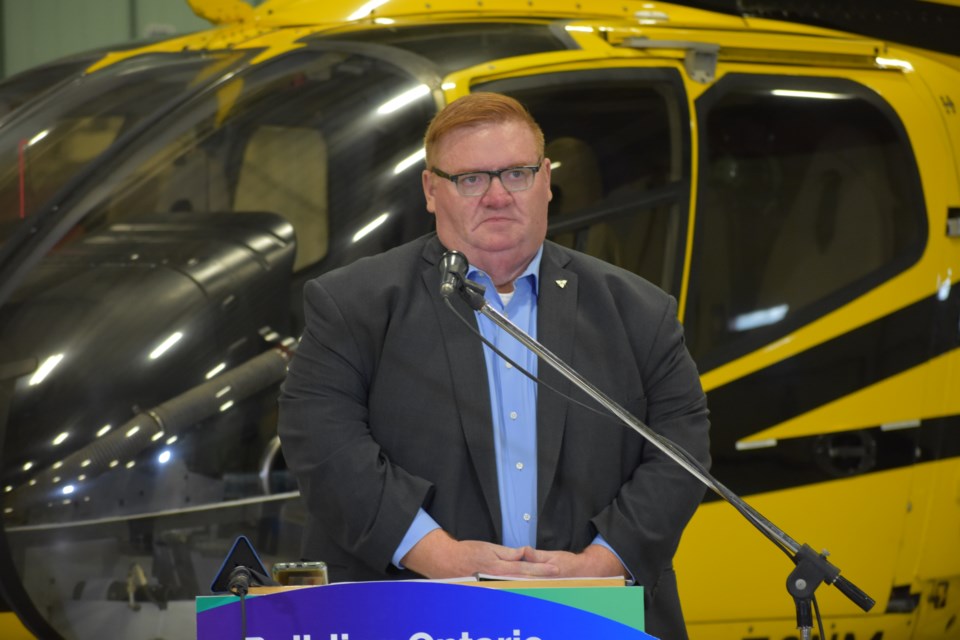An extra $20.3 million for wildland fire management isn't addressing the front-line staff retention crisis, says the union representing Ontario fire rangers.
Ontario Minister of Natural Resources and Forestry (MNRF) Graydon Smith was in Timmins Thursday for the funding announcement to buy new aerial suppression technology, build capacity in Indigenous communities, recruit new staff, and invest in more research into the science behind wildland fire management.
"Continuing to invest in Ontario's wildland fire program will allow us to be even better prepared to withstand wildland fire emergencies in the future and will help us continue to be able to keep people and property safe," said Smith at an event held at the MNRF hangar at the Timmins airport.
Local fire rangers who were not invited to the announcement set up outside with signs calling for changes to their job. The main asks are to reclassify the positions to allow for higher wages and benefit enhancements to acknowledge the health risks of the job.
“This summer alone, politicians were advising people to stay indoors when they were hundreds of kilometres away from the smoke and we were right in front of them, breathing them in all day for 14-19 days. We’re looking for a reclassification that … associates the risk that we take doing this job,” said Kevin Wallingford, a fire ranger working out of the Timmins district.
Right now, fire rangers are classified as a resource technician, which he says is the title of most government district employees working in the forest.
"We’re front lines fighting flames, we’re breathing in smoke, inhaling carcinogens — we don’t get regular medical testing for the stuff that we inhale on a day-to-day basis,” he said.
Wallingford has been on the front lines of wildland fires since 2015 and has seen the job go from a highly competitive role to hiring "anyone who wants the job".
This year in Ontario, OPSEU says there were about 200 fire ranger positions left empty.
The staffing issues mean that rangers are going out to more fires, staying out longer and they don't have the support that they used to, said Wallingford.
“Without having as many experienced people it’s definitely a lot riskier. The dangers are higher. 'Cause we have people who haven’t necessarily seen high-intensity flames and they’re out there making decisions that put people’s lives at risk and using multi-million dollar equipment and these are people who haven’t had the experience to necessarily know what they can handle,” he said.
It's been a very active forest fire season in Ontario.
So far, there have been 738 fires, compared to 268 in 2022. The 10-year average is 685 fires.
Smith didn't answer direct questions about how his ministry is improving benefits, retaining fire rangers or considering reclassifying the positions. Instead, he deferred to the Treasury Board, saying those conversations are happening there.
“It has been very, very top of mind for us that the fire rangers that we do have, we want to be able to support them. We’re here to listen to them, work with them and ensure that they’re in the very best situation to do that incredible job that they do every day,” he said.
In the announcement, the government says it's creating a psychological safety program for staff working in the wildland fire program. Eligible expenses for fire rangers' training and stand-by pay are also being reimbursed.
After the event, OPSEU regional vice president Tara Maszczakiewicz said they're "extremely disappointed".
"In complete contrast to his remarks, the decision to reclassify absolutely comes from the Minister — it could happen with the stroke of a pen. It is not part of the normal collective bargaining process," she said in a statement.
"With direction from the Minister, the Treasury Board can, and does, reclassify. It’s why OPSEU/SEFPO has brought this request to both the Treasury Board and the Minister. The Minister is at the helm, and it’s why he has been the main target of the forest fire workers’ campaign for fairness and respect."
Today's funding is new cash and will be rolled out over three years. Here's how it will be spent:
- $7.1 million to hire and train fire response staff
- $4.68 million for the natural resources disaster management review Be Ready
- $2.9 million for aerial suppression technologies and drones
- $2.97 million to partner to build capacity to support Indigenous communities
- $2.86 million to invest in science and risk assessment
The estimated overall annual breakdown is $7.57 million in 2022-23, $6.84 million in 2023-24, and $6.13 million in 2024-25.
